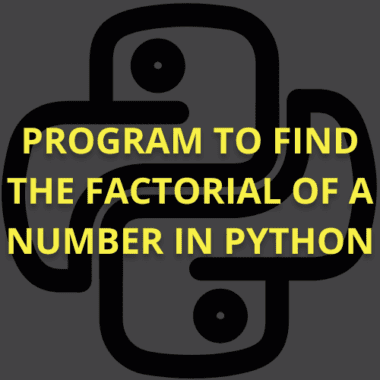Summary: Abstraction in Python simplifies complex systems, hiding implementation details for better code readability. Encapsulation safeguards data integrity by restricting direct access to an object’s data and methods. Together, they enhance code maintainability, security, and scalability, which are crucial for modern software development.
Introduction
This article explores the fascinating concepts of abstraction and encapsulation in Python. Delve into data abstraction in Python, understand its significance, and see abstraction in Python examples that clarify this essential programming principle.
Additionally, learn how abstraction and encapsulation in Python work together to create clean, efficient, and secure code. By the end, gain a comprehensive understanding of these techniques and their practical applications.
Have you ever wondered why encapsulation is crucial for protecting data in Python? This article provides the answers and equips readers with the knowledge to implement these concepts effectively.
Also, check out:
All You Need To Know About Writing A Function In Python.
Difference Between Python and Anaconda.
Understanding Data Abstraction in Python
Understanding data abstraction in Python involves simplifying complex systems. This concept explored through definitions, examples, and techniques, is essential for writing clear, maintainable, and efficient code.
Definition of Data Abstraction
Data abstraction in Python involves simplifying complex systems by modelling classes appropriate to the problem domain, thus allowing users to work with higher-level concepts rather than low-level details.
This concept only exposes the relevant aspects of data and functions while hiding implementation details. In software development, abstraction aids in managing complexity, enhancing code readability, and promoting reusability. It serves as a cornerstone for building robust and maintainable software systems.
Examples of Data Abstraction in Python
Using real-world analogies can make understanding data abstraction in Python more intuitive. Consider the operation of a car. A driver uses the steering wheel, pedals, and gear shift to control the car without understanding the intricacies of the engine, transmission, or fuel system.
This is an example of abstraction. The driver interacts with a simplified interface while the complex details remain hidden.
In Python, abstraction can be demonstrated through simple code examples. Here’s an abstraction in Python example:
In this example, the Animal class is an abstract class with an abstract method sound(). The Dog and Cat classes implement the sound() method, but the details of how the sound is produced are hidden from the user.
Techniques for Achieving Abstraction
Data abstraction in Python is typically achieved using abstract classes and interfaces. The ABC module (Abstract Base Classes) in Python provides a framework for defining abstract classes. An abstract class can have one or more abstract methods, which are declared but contain no implementation. Subclasses of the abstract class are required to implement these abstract methods.
The ABC module is employed to define abstract classes:
In this example, the Shape class is an abstract class with an abstract method area(). The Rectangle class provides the specific implementation of the area() method. This technique ensures that any Shape subclass will have a consistent interface for calculating the area, promoting a clear and cohesive design.
Understanding and implementing data abstraction in Python is fundamental for building efficient and scalable software. Abstraction simplifies the development process and enhances code maintainability and reusability by focusing on the essential features and hiding the intricate details.
Must Read:
A/B Testing for Data Science using Python.
What is Armstrong Number in Python?
Understanding Encapsulation in Python
Encapsulation is a fundamental concept in object-oriented programming that restricts direct access to an object’s data and methods. This practice helps safeguard the integrity of the data and promotes modular design, ensuring that objects manage their state. Let’s delve into how Python implements encapsulation and explore some practical examples.
Definition of Encapsulation
Encapsulation refers to the bundling of data and methods that operate on that data within a single unit or class. It also involves restricting access to specific components to prevent unintended interference and misuse.
Encapsulation protects data within an object from outside interference and misuse, ensuring that it is only modified in controlled ways. This approach enhances the security and robustness of the code.
Encapsulation in Python
Python handles encapsulation by supporting private and protected members within classes. Unlike some languages that enforce strict access controls, Python uses a convention-based approach.
Firstly, private members are denoted by a double underscore prefix (__). They are not accessible directly from outside the class and are meant for internal use only within the class.
Meanwhile, protected members are indicated by a single underscore prefix (_). While they are not as strictly enforced as private members, protected members are intended to be used only within the class and its subclasses.
Though Python’s encapsulation is not enforced strictly by the language, adhering to these conventions is crucial for maintaining clean and maintainable code.
Examples and Code Snippets
Here is an example that demonstrates encapsulation in Python using a class with private and protected members:
In this example, __account_number is a private member, and _balance is a protected member. The class provides methods to interact with these members, ensuring that the internal state is modified only in controlled ways. This encapsulation protects the integrity of the BankAccount class’s data, demonstrating the practical benefits of encapsulation in Python.
Also, take a look at:
Importing Data in Python Cheat Sheet with Comprehensive Tutorial.
Your Essential Python Cheat Sheet For Beginners: Mastering Python Basics.
Implementing Abstraction and Encapsulation Together
In Python programming, combining abstraction and encapsulation is like constructing a sturdy fortress for your code. Let’s explore how these two powerful concepts can harmonise to fortify your Python projects.
Combining Concepts
Abstraction and encapsulation are like two peas in a pod, complementing each other to enhance code reliability and scalability. By abstracting away intricate implementation details and encapsulating data within well-defined boundaries, we pave the way for robust and maintainable code structures.
Step-by-Step Implementation
Embarking on our journey towards amalgamating abstraction and encapsulation, let’s unravel a comprehensive example showcasing their symbiotic relationship. Through a step-by-step breakdown, we’ll navigate the intricacies of integrating these concepts seamlessly within a single Python project.
Identify Abstraction Points: Pinpoint areas where abstraction can simplify complex functionalities into manageable components.
Define Clear Interfaces: Establish clear interfaces for interaction, concealing internal complexities while providing a streamlined pathway for external communication.
Encapsulate Data: To safeguard data integrity, encapsulate data within classes and control access through well-defined interfaces and access modifiers.
Utilise Abstract Base Classes (ABCs): Leverage Python’s ABC module to define abstract base classes, enforce structure, and ensure adherence to defined contracts.
Best Practices
Adhering to best practices is paramount to merging abstraction and encapsulation within your Python projects. Here are some guiding principles to steer you in the right direction:
Modularity: Break down your code into modular components, each encapsulating a specific functionality.
Information Hiding: Conceal implementation details are not pertinent to external users, promoting a clear separation of concerns.
Consistent Naming Conventions: Adopt consistent naming conventions for classes, methods, and variables, enhancing code readability and maintainability.
Documentation: Document your code comprehensively, elucidating the purpose of abstractions and encapsulated data structures to aid future developers.
Adhering to these best practices allows you to seamlessly integrate abstraction and encapsulation, fostering codebases that are not only robust but also conducive to future expansion and maintenance.
Incorporating abstraction and encapsulation in tandem empowers us to construct Python projects that are functional and resilient to the evolving demands of software development.
Benefits and Applications
Unlocking the potential of abstraction and encapsulation in Python yields numerous benefits. Through case studies, explore their impact on code readability, maintainability, security, and real-world applications.
Advantages of Using Abstraction and Encapsulation
When discussing the advantages of employing abstraction and encapsulation in Python, we delve into the fundamental aspects that elevate our code quality and robustness.
Improved Code Readability
Implementing abstraction allows us to focus on essential details while hiding unnecessary complexities. This makes the code easier for us and other developers to understand, facilitating smoother collaboration and maintenance.
Enhanced Maintainability
Encapsulating data and functionality within classes creates clear boundaries and reduces dependencies between different parts of our code. This modular approach simplifies updating or modifying specific features without affecting the entire system, thus improving maintainability over time.
Enhanced Security
Encapsulation enables us to control access to sensitive data and methods, restricting direct manipulation from external sources. By hiding implementation details and exposing only the necessary interfaces, we mitigate the risk of unintended modifications or unauthorised access, thereby enhancing the security of our applications.
Real-World Applications
The practical implications of abstraction and encapsulation extend across various industries and scenarios, demonstrating their versatility and effectiveness in real-world applications.
Software Development
In software development, especially in large-scale projects, abstraction and encapsulation are crucial in managing complexity and promoting code reusability. By abstracting standard functionalities into reusable components and encapsulating related data and behaviours within classes, developers can streamline the development process and ensure scalability and flexibility in their applications.
Data Science and Machine Learning
In Data Science and Machine Learning, where handling complex datasets and models is commonplace, abstraction and encapsulation help researchers and practitioners organise and manage their codebase effectively.
By encapsulating data preprocessing pipelines, model architectures, and training algorithms within classes and modules, Data Scientists can maintain cleaner and more maintainable code, enabling easier experimentation and iteration on their models.
Case Studies
Examining case studies and examples from well-known Python projects provides concrete evidence of abstraction and encapsulation benefits and practical applications.
Django Web Framework
Django, a popular web framework written in Python, employs abstraction and encapsulation extensively to provide a high-level, reusable architecture for building web applications.
By abstracting common web development patterns into reusable components (such as models, views, and templates) and encapsulating data access and business logic within Django’s ORM (Object-Relational Mapping) layer, developers can quickly develop robust and scalable web applications with minimal boilerplate code.
Pandas Data Analysis Library
Pandas, a powerful Data Analysis library for Python, leverages abstraction and encapsulation to provide intuitive and efficient tools for manipulating structured data.
By abstracting data structures like DataFrames and Series and encapsulating data manipulation operations within specialised methods and functions, Pandas easily enables Data Scientists and analysts to perform complex data transformations and analysis tasks, fostering a productive and collaborative Data Analysis workflow.
Read Further:
How to Use ChatGPT APIs in Python?
How to Tabulate Data in Python?
Common Pitfalls and How to Avoid Them
Navigating common pitfalls in abstraction and encapsulation is vital for robust code. Learn to recognise errors, troubleshoot effectively, and implement best practices for smoother development.
Frequent Mistakes
Navigating the programming journey inevitably involves slips. Developers frequently encounter blunders while delving into abstraction and encapsulation. Such missteps are inherent, fostering growth and understanding. Recognising these common errors is crucial for refining coding skills and mastering the intricacies of software development.
Exposing Implementation Details
One of the most prevalent mistakes is revealing too much about how your code works internally. This defeats the purpose of abstraction, as it exposes the inner workings and undermines the security and flexibility that encapsulation offers.
Violating Access Control
Forgetting to enforce access control mechanisms properly can lead to data leaks and unexpected behaviour. To maintain data integrity and encapsulation, it’s crucial to mark your variables and methods with appropriate access modifiers, such as private or protected.
Tight Coupling
Tightly coupling classes or modules can make your code rigid and challenging. Aim for loose coupling by decoupling dependencies and relying on abstractions rather than concrete implementations.
Troubleshooting Tips
Identifying and rectifying mistakes is an integral part of the development process. Here are some tips to help you troubleshoot and resolve common pitfalls in abstraction and encapsulation.
Code Review
Engage in regular code reviews to catch implementation leaks and access control violations early on. A fresh pair of eyes can often spot issues you have overlooked.
Testing
Comprehensive testing, including unit and integration tests, can uncover bugs and vulnerabilities caused by tight coupling or improper encapsulation. Make testing a habit to ensure the robustness of your code.
Refactoring
Feel free to refactor your code if you discover design flaws or violations of best practices. Refactoring allows you to improve your codebase and enhance its maintainability iteratively.
Best Practices and Recommendations
Prevention is better than cure, they say. Here are some best practices and recommendations to help you avoid common pitfalls and foster a healthier coding environment.
Design with Abstraction in Mind:
Start by clearly understanding the problem domain and designing your code with abstraction in mind. Identify the essential components and their interactions before diving into implementation details.
Follow the Principle of Least Privilege
Adhere to the principle of least privilege when designing access control mechanisms. Only expose what is necessary and restrict access to sensitive data or methods to minimise the risk of unintended consequences.
Embrace SOLID Principles
Familiarise yourself with the SOLID principles of object-oriented design, particularly the Single Responsibility Principle (SRP) and the Dependency Inversion Principle (DIP). These principles provide guidelines for creating maintainable and loosely coupled code.
By mindfully following these tips and principles, you can navigate the complexities of abstraction and encapsulation more effectively, leading to cleaner, more maintainable code.
Frequently Asked Questions
What is Data Abstraction in Python?
Data abstraction simplifies complex systems by modelling classes, allowing users to work with higher-level concepts. It hides implementation details, enhancing code readability and promoting reusability.
How Does Encapsulation Protect Data in Python?
Encapsulation restricts direct access to an object’s data and methods, safeguarding data integrity. Python enforces encapsulation using conventions like double underscore prefixes for private members.
Why Are Abstraction and Encapsulation Essential in Python?
Abstraction simplifies development by focusing on essential features, while encapsulation protects data integrity. They improve code readability, maintainability, and security in Python projects.
Closing Statements
Mastering abstraction and encapsulation in Python is crucial for building efficient, scalable, and secure software. By simplifying complexity, hiding implementation details, and safeguarding data integrity, developers can create robust and maintainable codebases that meet the demands of modern software development.
Enrolling in Pickl.AI’s Python for Data Science course is a strategic move for aspiring Python developers. This course, curated by seasoned Python programmers, focuses on practical application and industry-relevant skills.
Each module is designed to provide a thorough understanding of Python’s capabilities, from core Python concepts to advanced libraries like NumPy and Pandas. With self-paced learning modules and expert support, this online course ensures a flexible and immersive learning experience, empowering students to excel in Python development.




